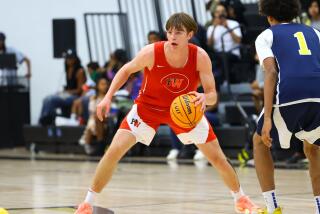Bakersfield: All It Takes Is a Winner : College basketball: Cal State Roadrunners are the kings of the city because they are successful.
BAKERSFIELD — This is a city that desperately wants to change its image with the people “over the hill” in Los Angeles. It’s a place where anything un-American is out and Roadrunner basketball is king of the road.
Located on the rapidly expanding southwestern edge of the city, Cal State Bakersfield has captured the pulse of Kern County with its highly successful basketball team that has won more than 75% of its games over the past 10 years and advanced to the Division II Final Four four times.
It may not be Division I, but on a local scale, this could be Westwood, Chapel Hill or Durham, although it also has been called little Oklahoma because of the migration from the Dust Bowl in the 1930s. Many of those Dust Bowlers form the middle class in Bakersfield, and they don’t seem to mind plunking down $150 each for the right to buy basketball season tickets. Sales of season tickets topped 1,500 this season, and it has become increasingly common for the three-year-old, $5.5-million Activities Center, which seats 3,800, to sell out.
The team is so popular that some road games are televised live on one of three network affiliates in town, and the basketball coach has his own TV talk show that has aired in prime time. When the Roadrunners play, the reports are on the front of the sports section of the Bakersfield Californian, and all games, home and away, are broadcast live on radio.
The coach has a recruiting and scholarship budget that would make some counterparts at larger state universities cringe.
“This is the top show in town,” said Richard Ross, a sales executive for the NBC-TV affiliate and a Roadrunner basketball player from 1971-73.
Bakersfield has a history of supporting its athletic teams. Bakersfield College has a 20,000-seat football stadium. The results of high school sports, including non-mainstream sports such as wrestling and soccer, are reported on television.
“This has always been a darn good athletic town,” said longtime resident Ed Richardson, who has followed the Roadrunners for 20 years. “We just back athletics here.”
But townspeople appear to rally around the ‘Runners, as they are known, like no other. When the Activities Center was built, fans funded its completion by purchasing all 680 cushioned seats at midcourt for $500 each. A 2,000-square-foot, $100,000 reception room adjacent to the arena floor was financed by a long-time booster, who asked only that it be named after his family. It’s estimated that boosters chipped in an additional $750,000 to upgrade the facility, which is the only gymnasium in the state college system that is air conditioned.
Since the first Cal State Bakersfield basketball team played in 1971, university officials have gone out of their way to maintain a down-home relationship with residents, some of whom are spread over miles and miles of farmland.
“Coming to a Roadrunner game is a social event,” said Ken Vaughan, an accountant who is outgoing president of the Roadrunner Club, an 800-member booster group. “Some of us don’t see each other all week until we meet Friday or Saturday night at a game.”
Since it opened in 1970, the school has not fielded a football team because, it says, it did not want to compete for fan support with the well-established football team at the community college. Residents here are fiercely loyal, often casting a wary eye toward outsiders. A Continental Basketball Assn. team called the Jammers, which played its games in the downtown Civic Arena, folded in midseason recently. Management cited its poor fiscal condition as the reason for the team’s failure, but some locals suggest that Bakersfield wasn’t ready to support a team that was run by outsiders.
Said Jacqueline Kegley, a philosophy professor who sits on the athletic department’s advisory board that has recommended that Bakersfield move up to Division I: “We have the type of community with vision, and we put our money where our mouth is.”
But more than likely the success rate of Roadrunner basketball brings people out.
“This town has always demanded top-caliber coaches, and those coaches knew they had to win,” Vaughan said. “I don’t think this community would support someone who didn’t work hard and didn’t win.”
That attitude also had had an effect on the other seven sports at the school. The swimming team has won six consecutive national titles, and the softball team won three consecutive national titles from 1988-90.
Yet, sometimes even winning isn’t enough. Former basketball coach Jim Parks never had a losing season and went 76-35 in four years, including two 20-plus-victory seasons. But following the team’s 5-9 seventh-place finish in the California Collegiate Athletic Assn. in 1987 (16-11 overall), Parks was run out of the job by angry boosters.
Said Bakersfield Coach Pat Douglass: “This is a pretty aggressive community that likes a winner, so you better win.”
Douglass is a graduate of University of the Pacific, where he played basketball. He grew up in Barstow and is a straight-forward instructor whose unflappable demeanor is often mistaken for aloofness. He does not use a whistle in practice, commanding, instead, that his players listen for his instructions. He logs months on the road during recruiting trips and is known as being demanding, but fair, by his players.
“He is very intense, but on the outside he is very soft spoken,” senior forward Beau Redstone said. “He doesn’t care who you are. If you don’t play the way he wants--with a lot of intensity--you are just not going to play.”
Now in his fifth season at the school, Douglass replaced Parks, and Bakersfield promptly shared the 1988 CCAA title, finishing third in the NCAA Western Regional. A year later, Bakersfield was the Western Regional runner-up. Two years ago the Roadrunners were 29-5 and advanced to the Division II championship game, where they lost to Kentucky Wesleyan, 93-79. Last season they were eliminated in overtime in the semifinals by the University of Bridgeport, 73-66. The Roadrunners were 25-8. Currently they are 20-5. With a 9-3 conference record, they are two games behind CCAA-leading UC Riverside.
Douglass has won 20 or more games each year he has been at Bakersfield. His winning percentage, which includes six years at Eastern Montana, is better than 70%. He has taken teams to the Division II Final Four in three of the last five seasons. He is the only coach in the school’s history to receive a multiyear contract--a three-year pact believed to be worth about $70,000 a year, plus a car allowance. Douglass and Athletic Director Rudy Carvajal said university officials have kept a lid on perks for coaches, preferring, instead, to use donations for the entire athletic program. Douglass said he paid for his membership in the Stockdale Country Club, and that he does the TV show solely as “a learning experience.”
He scours the country for recruits but understands the need to attract top players from the southern San Joaquin Valley. In November, he landed a top player in the city. This year’s roster represents seven states, although only two players are from Bakersfield.
Russell Jarvis, a 6-foot-10 senior transfer from Boston University, takes pride in the fact that both he and Redstone are heroes to many of today’s youthful spectators.
“Everyone has accepted me,” he said. “It’s a really warm feeling here. It’s a big city, but everyone knows who you are.”
Keeping fans happy goes a long way toward paying the bills, Carvajal said. Local fund-raising is a major part of the school’s athletic program. The school’s overall athletic budget of $2 million includes donations of more than $600,000 a year. It’s estimated that 85% of all the money spent on athletics at Bakersfield comes through some type of fund-raising activity.
Basketball receives about $200,000 a year in working capital and offers 12 scholarships, the maximum allowed by the NCAA. Several CCAA schools have fewer. Cal State Dominguez Hills in Carson, which took up fund-raising three years ago, has three scholarships to split among 12 players.
Said Carvajal: “From the get-go we have been involved with the community because of the fiscal reality that there was just no money there (from the state) to get done what we wanted to.”
With 5,300 students attending a relatively new school, the Roadrunners have never had a strong alumni base to turn to. Only 360 alumni showed up for a dance and barbecue before a recent game with Cal Poly San Luis Obispo. Raising all that money is a year-round process that takes three full-time people, in addition to much of Carvajal’s time. It has been largely successful, according to Carvajal, because university officials are willing to roll up their sleeves and pitch in with the local folk. Last spring 5,000 people crowded into the Kern County Fair Grounds for the annual barbecue that featured country and western music and players and coaches busing tables and cooking meals.
The latest fund-raising project--a house under construction in an exclusive neighborhood near the campus--figures to generate $350,000 in income when it is sold. That’s money Carvajal hopes will offset a 40% tuition hike for scholarships, the result of the state budget crisis.
Douglass, however, bristles at the suggestion that Cal State Bakersfield is “loaded,” with easy money generated by wealthy farmers and oilmen, a charge leveled by some CCAA schools.
“It’s a misconception that this is ‘Fat City,’ ” he said. “When these people dip into their pockets, it’s not easy.”
But, said Ross, the former player: “We have the advantage over other schools (that are in Los Angeles) because they can’t be the top show in town. Here we are a self-contained city.”
That is changing, and men like Atkinson hope the impression outsiders have of the town changes with it.
“Most people to the south have the perception of Bakersfield as being the time that their car broke down here,” he said. “But once they are here and we explain what we have and what we do, a lot of them move here.”
More to Read
Go beyond the scoreboard
Get the latest on L.A.'s teams in the daily Sports Report newsletter.
You may occasionally receive promotional content from the Los Angeles Times.










